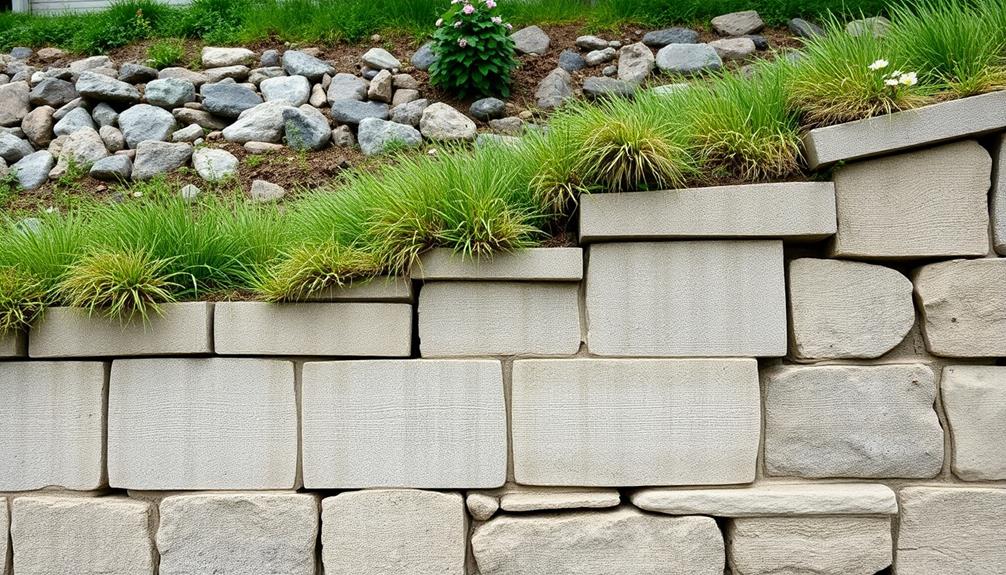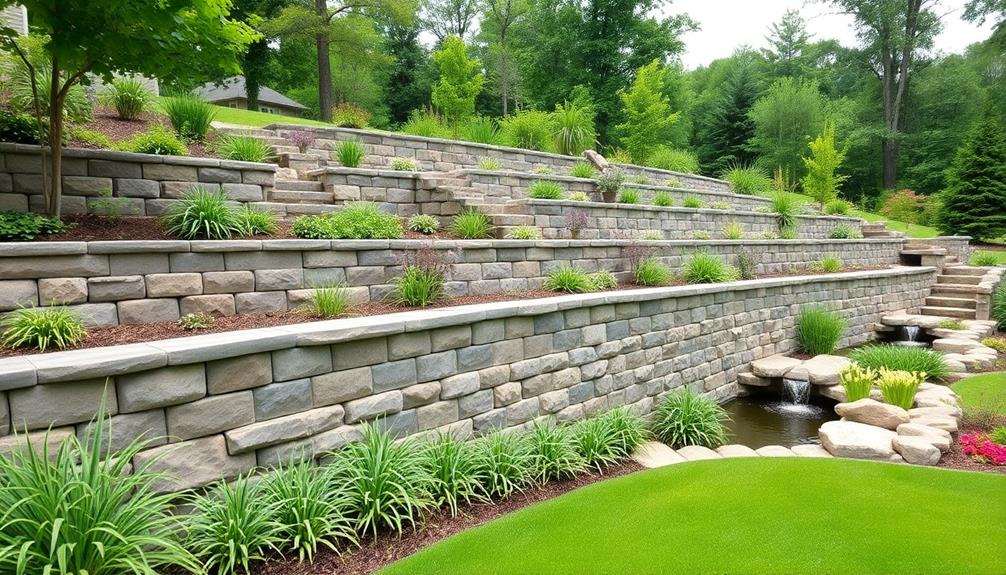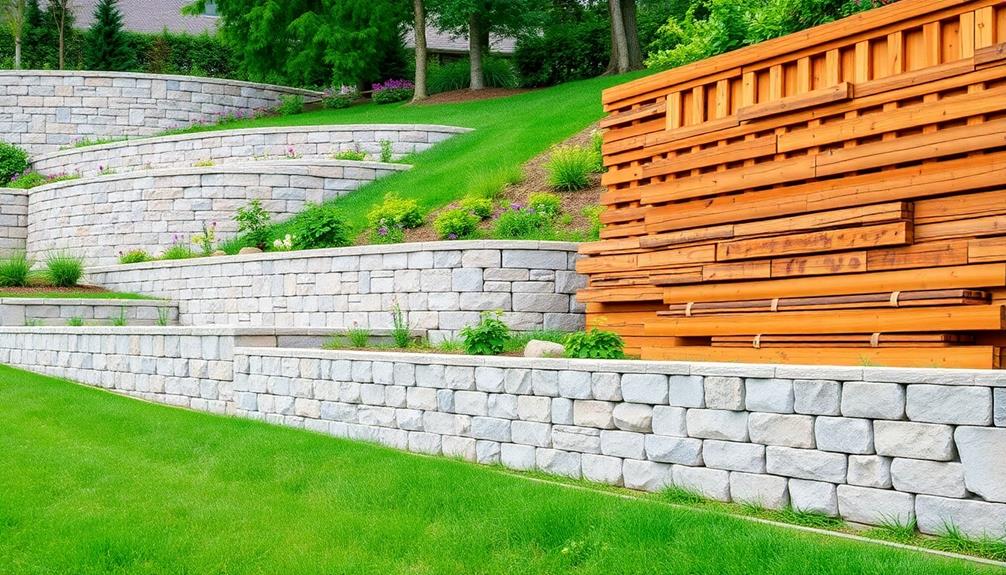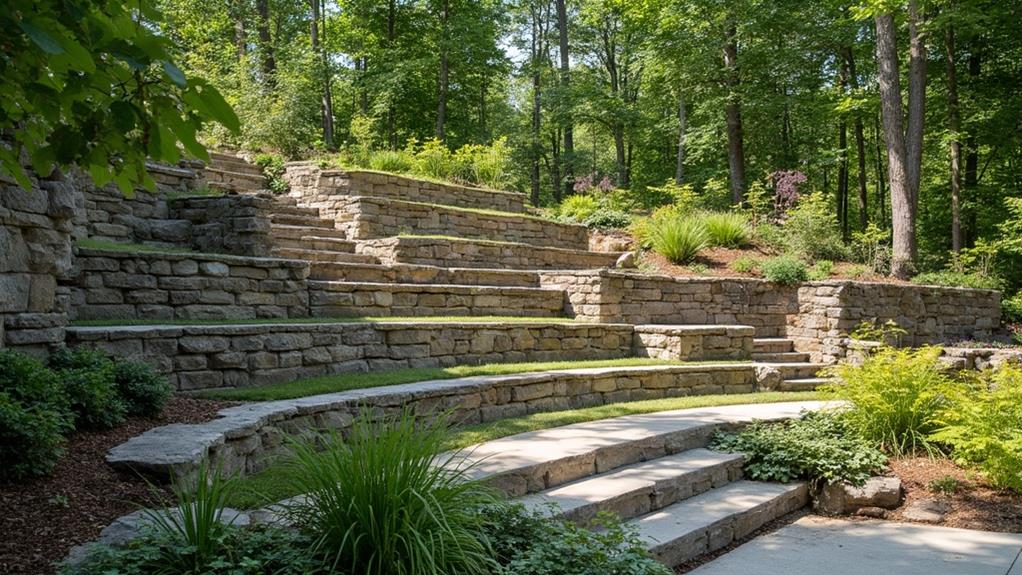The key principles of retaining wall design involve ensuring structural stability, efficient drainage management, careful material selection, thorough structural analysis, and meticulous construction methodology. Stability is achieved by analyzing weight, friction, and lateral pressures, while incorporating anchoring systems and considering seismic forces. Effective drainage management requires integrating weep holes or embedded drains, evaluating soil type, and designing systems to prevent erosion. Material selection involves choosing durable, aesthetically cohesive options like natural stones or reinforced concrete, factoring in sustainability and cost. An exhaustive structural analysis determines the appropriate wall type and reinforcement needs. By following these principles, the wall's functionality and longevity are secured.
Table of Contents
ToggleWalls Contractor Highlights
- Ensure stability by analyzing weight, friction, and load-bearing capacity to prevent tipping or sliding.
- Integrate effective drainage management to alleviate water pressure and prevent erosion.
- Select appropriate materials considering structural requirements, aesthetics, and environmental impact.
- Conduct a comprehensive structural analysis to evaluate lateral earth pressures and soil conditions.
- Follow proper construction methodology for site preparation, quality control, and adherence to specifications.
Definition of Retaining Walls

Retaining walls are vital structures in construction, primarily designed to restrain soil and prevent erosion while supporting vertical or near-vertical grade changes. Their purpose and functionality are diverse, as these walls can be built using various types and materials, ranging from concrete and stone to timber and steel, each chosen based on specific environmental and aesthetic considerations.
Boulder retaining walls offer a powerful and natural appearance, making them an excellent choice for those seeking a durable and visually striking solution. Furthermore, structural considerations such as soil type, load-bearing capacity, and drainage solutions are pivotal in determining the design and stability of these essential barriers.
Purpose and Functionality
A profound understanding of the purpose and functionality of retaining walls is critical in civil engineering and landscaping. These structures are engineered to provide essential support when there is a need to retain soil or other particulate materials, preventing natural movement that could lead to erosion, landslides, or unwanted landscape alteration. By maintaining the edges of elevated terrains, retaining walls establish terrains conducive to construction activities, making previously impractical areas suitable for development.
In addition, they contribute to drainage management, often incorporating drainage pipes to prevent water accumulation that could jeopardize structural integrity.
The functionality of retaining walls extends beyond mere support. They serve as protective barriers, ensuring the stabilization of earth masses along embankments and controlling water flow in regions prone to heavy rainfall. By harmoniously integrating with the environment, these walls fulfill aesthetic roles, enhancing landscape appearances while providing structural benefits. Retaining walls also enable the creation of usable land on sloped terrains, thereby expanding available space for gardens, patios, or roadways.
Appreciating the purpose and functionality of retaining walls fosters a deeper connection with the land, encouraging conscientious and sustainable design practices that consider both functionality and the natural ecosystem.
Types and Materials
Various types and materials define the domain of retaining walls, each chosen based on structural requirements, functional demands, and aesthetic preferences. Retaining walls can be constructed using a variety of materials, ranging from natural stones, which provide a timeless and classic look, to advanced materials like reinforced concrete, which offers unparalleled strength and durability. These materials align not only with the engineering requisites of a project but also resonate with the surrounding environment, creating a seamless integration that nurtures a sense of belonging among residents and users of the space.
In classifying retaining walls, types such as gravity walls, cantilevered walls, anchored walls, and sheet pile walls emerge, each possessing distinct characteristics suited for specific conditions. Gravity walls rely on their mass to resist the pressure of the retained material, while cantilevered walls, often made from reinforced concrete or steel, use the principles of leverage for support. Anchored walls, on the other hand, derive their stability from cables or other elements secured into the ground, and sheet pile walls employ sections of steel to withstand lateral pressures. These diverse materials and types guarantee that retaining walls serve both functional and aesthetic roles, promoting harmony and durability in various landscapes.
Structural Considerations
Understanding retaining walls extends beyond just their types and materials; the structural considerations play a pivotal role in their design and functionality. A retaining wall's purpose is to resist lateral pressure caused by soil or other materials behind it, necessitating a careful assessment of several key structural factors. These include stability, load-bearing capacity, and the ability to manage pressure caused by water buildup and soil movement.
Stability is paramount; a retaining wall must withstand the forces acting upon it without tipping or sliding. This involves analyzing the weight and friction of the structure against the potential movement of retained material. Furthermore, guaranteeing adequate load-bearing capacity involves calculating the weight that the wall must support. Engineers must carefully estimate loads from soil, additional materials, and environmental factors like floods and earthquakes.
Proper drainage is another integral consideration, as water accumulation behind the wall can dramatically increase lateral pressure and lead to failure. A well-designed drainage system, such as weep holes or embedded drains, alleviates this pressure, safeguarding the wall's structural integrity.
These inclusive structural considerations guarantee that retaining walls appropriately serve their intended function, offering safety and longevity to the communities they protect.
Benefits

Retaining walls are integral not only for their functional capacity to prevent soil erosion and enhance stability but also for their ability to markedly increase property value by augmenting usable space and improving the overall aesthetic appeal of the landscape. These structures provide a dual benefit of addressing environmental concerns while simultaneously elevating the property's visual and practical attributes.
Limestone wall installation offers an elegant and natural look, providing excellent support and preventing erosion while contributing to the overall aesthetic of the landscape. Through careful planning and execution, retaining walls can transform uneven and unusable terrain into a harmonious and inviting extension of the built environment.
Enhances Property Value
Additionally, a well-designed retaining wall can markedly enhance property value, offering a substantial return on investment for homeowners. In the domain of real estate, aesthetic appeal and functional enhancements play pivotal roles in influencing property valuation.
A retaining wall achieves this dual purpose by transforming uneven terrain into a visually appealing and usable landscape, simultaneously amplifying both curb appeal and utility. The wall's presence provides the opportunity for tailored landscaping options, such as creating garden terraces, which in turn enhance the overall visual appeal of the property, inviting admiration and providing satisfaction to homeowners seeking a sense of belonging within their communities.
Furthermore, a strategically placed retaining wall can maximize the usability of outdoor spaces, offering homeowners the opportunity to extend their living areas into the outdoors. This functionality is particularly beneficial in residential settings where flat, usable land is at a premium.
Prevents Soil Erosion
Beyond increasing property value, a retaining wall serves an essential function in preventing soil erosion, a benefit critical for maintaining the structural integrity of both the wall itself and the surrounding landscape. When hillsides or sloped terrains are exposed, the soil can be vulnerable to erosion from wind, rain, and other environmental factors. This can lead to detrimental effects on not only the landscape but also on the stability of structures in the vicinity.
By anchoring the soil, retaining walls mitigate these risk factors by providing a physical barrier designed to manage and direct water flow, substantially reducing sediment displacement. Such walls are meticulously engineered to withstand the pressures exerted by the earth they hold back, incorporating features like proper drainage to avert water accumulation which could undermine the construction's foundation. By integrating these technical aspects into their design, retaining walls provide property owners with a sustainable solution to soil erosion that gives peace of mind, knowing their surroundings remain secure and intact.
For communities concerned about maintaining the environmental harmony and aesthetic of their surroundings, retaining walls present themselves as both a practical and visually appealing choice, reinforcing a sense of belonging and stewardship over one's environment.
Increases Usable Space
One of the significant benefits of retaining walls is their ability to increase usable space on a property. In areas characterized by hilly or uneven terrain, these engineered structures provide a practical solution for homeowners and developers seeking to maximize land utilization.
By effectively holding back soil and creating level terraces, retaining walls facilitate the creation of larger flat surfaces that can accommodate a wide range of functional spaces, such as patios, gardens, or additional building areas. This transformation not only enhances the utility of the land but also fosters a sense of collective integration with the natural environment.
Retaining walls enable communities to optimize their residential and commercial estates, reflecting thoughtful design and planning that accommodates collective needs. By redefining previously unusable or inaccessible land, they offer a strategic means to expand living or recreational areas, consequently promoting a sense of inclusion and enhanced lifestyle quality for the occupants.
These newfound spaces can facilitate social interaction, fostering community bonds while offering increased opportunities for relaxation and outdoor enjoyment. When strategically integrated into landscape design, retaining walls exemplify an approach that is both aesthetically and functionally adept, demonstrating an understanding of the inherent value of land as a shared resource.
Improves Aesthetic Appeal
Aesthetics play a crucial role in the design of retaining walls, transforming what may traditionally be perceived as utilitarian structures into visually pleasing elements of a landscape. The strategic incorporation of varied materials, textures, and colors can greatly enhance the appeal of outdoor environments, thereby creating a harmonious balance between functionality and visual interest.
Contemporary designs enable retaining walls to complement natural surroundings, providing continuity that resonates with residents who desire a cohesive community aesthetic.
When thoughtfully designed, these walls become integral components of the landscape, contributing to a sense of place and identity. The use of natural stone, brick, or concrete can reflect local architectural styles, adding value to properties by seamlessly blending with existing features. In addition, incorporating features such as plantings or integrated lighting can augment the aesthetic quality, transforming these structures into focal points rather than mere boundary markers.
In addition, retaining walls serve not only as structural necessities but as opportunities for creative expression within communal spaces. By aligning with the artistic vision of landscape architecture, they invoke a shared sense of belonging, fostering environments where individuals connect with one another and with the spaces they inhabit, reinforcing the bonds within their community.
Types of Retaining Wall Materials

When selecting materials for retaining walls, considerations often include functionality, aesthetic appeal, durability, and environmental impact, with popular choices ranging from concrete block options, known for their strength and versatility, to natural stone varieties which provide an organic and timeless appearance, and wood retaining alternatives that offer a more rustic and cost-effective solution. Each material presents unique benefits and challenges, which are critical to evaluate in the context of the project's specific requirements and site conditions. Below is a comparative table highlighting key attributes of these materials.
| Material Type | Strength and Durability | Aesthetic Appeal |
|---|---|---|
| Concrete Blocks | High | Modern |
| Natural Stone | Medium | Timeless |
| Wood | Variable | Rustic |
| Cost-Effectiveness | Medium | Medium |
| Environmental Impact | High | Low to Medium |
Concrete Block Options
Concrete blocks have become a staple in the design and construction of retaining walls due to their durability and versatility. Engineered with precision, these blocks offer a myriad of design options that cater to varying aesthetic and structural needs. Concrete blocks are available in a range of sizes, colors, and textures, allowing for customization to match the architectural intent and landscape features. Their modular design enables easy assembly, facilitating the creation of seamless patterns and contours that integrate into the surrounding environment, thereby providing a sense of cohesion and harmony.
Additionally, concrete blocks are exemplified by their strength and longevity. Made from a mixture of cement, water, and aggregates, they are formidably resistant to environmental degradation. This resistance guarantees that the structures remain steadfast, even amidst varying weather conditions, offering a stable solution for soil retention and erosion control. Their interlocking capabilities reduce the need for mortar, thus enhancing structural stability while simplifying installation logistics.
Cost-effectiveness further enhances their appeal. With a broad price range that accommodates most budgets, concrete blocks present an economical option for retaining walls without sacrificing quality or performance, rendering them a favored choice among both professional builders and DIY enthusiasts.
Natural Stone Varieties
Natural stone retains an enduring charm as a choice for retaining wall construction, merging functionality with timeless appeal. This material offers a distinctive character that harmonizes with the environment, reflecting both the surrounding landscape and the home's architecture. Varieties such as granite, limestone, sandstone, and fieldstone each bring unique attributes, making them versatile options depending on aesthetic preferences and site-specific demands.
Granite, with its immense durability and range of colors, is ideal for structural strength and offers a sleek, polished finish. Limestone, known for its subtle texture and warmer hues, is suited for creating a natural look that seamlessly integrates with outdoor landscapes. Sandstone, appreciated for its light weight and varied color palette, is well-suited to those seeking a softer, more rustic appearance. Fieldstone, often irregularly shaped, provides a rugged, organic feel and is exemplary for creating a more casual, country appeal.
The choice of natural stone involves considerations of climate resilience, local availability, and necessary maintenance. Engaging with these materials fosters not only a connection to the earth and traditions of craftsmanship but also secures a lasting, durable solution tailored uniquely to the landscape and architectural ethos of the given location.
Wood Retaining Alternatives
While natural stone offers enduring charm and durability, wood retaining alternatives present their own set of appealing attributes, particularly in applications where budget constraints or specific aesthetic goals direct material choice.
Wood offers a warm, organic appearance that blends harmoniously with garden landscapes and rural settings, providing an inviting atmosphere that fosters a sense of unity with nature. Commonly utilized wood types include pressure-treated timber, Douglas fir, and redwood, each chosen for their relative affordability and ease of installation compared to more labor-intensive stone and masonry options.
In terms of sustainability, wood sourced from responsibly managed forests can be an environmentally considerate choice. Pressure-treated wood, specifically, is enhanced with preservatives to resist decay and insect damage, extending its functional lifespan and minimizing maintenance needs. Nonetheless, the longevity of such materials is typically shorter than that of stone or concrete, prompting consideration of periodic replacement.
Despite this, wood's adaptability in crafting curved lines and dynamic shapes allows for creative design flexibility. Thus, for communities seeking an eco-friendly, cost-effective solution that aligns with aesthetic desires and a deeper connection to the environment, wood retaining walls provide an admirable alternative.
Walls Contractor FAQ
How Do I Determine the Height and Width of My Retaining Wall?
To determine the height and width of your retaining wall, conduct a site assessment. Consider factors like soil type, slope gradient, and drainage. Collaboration with a structural engineer guarantees stability, promoting safety and community integration.
What Drainage Considerations Are Crucial for Retaining Wall Design?
Effective drainage is essential to prevent hydrostatic pressure buildup behind retaining walls. Incorporate weep holes, gravel backfill, and perforated drainage pipes to guarantee proper water flow and protect the structural integrity, fostering a safe environment for all.
How Does Soil Type Impact Retaining Wall Stability?
The type of soil greatly influences retaining wall stability. Cohesive soils provide better support, increasing wall stability, whereas non-cohesive soils require enhanced design considerations. Knowledge of soil characteristics fosters informed decisions, ensuring safe, lasting retaining structures for community use.
What Safety Standards Should Be Followed in Retaining Wall Construction?
Safety standards in retaining wall construction include adherence to local building codes, ensuring structural integrity through appropriate materials and design, conducting thorough geotechnical assessments, and incorporating drainage systems to avert hydrostatic pressure and promote community safety and reliability.
How Can I Prevent Hydrostatic Pressure Behind My Retaining Wall?
To mitigate hydrostatic pressure behind a retaining wall, incorporate proper drainage systems, such as weep holes or drainage pipes, and use coarse granular backfill. Ensuring effective water management fosters stability and safety, aligning with best construction practices.







